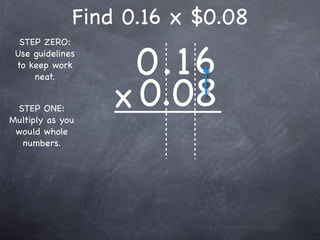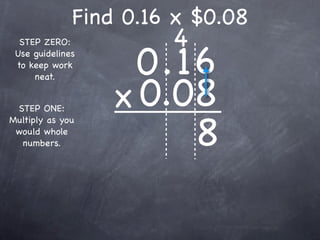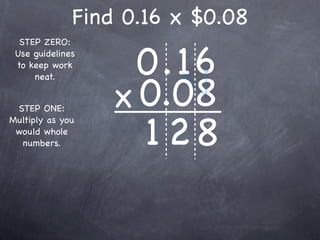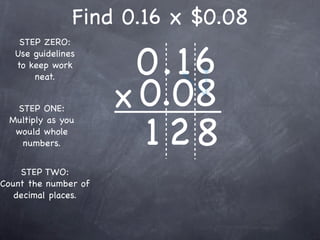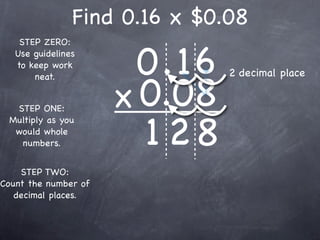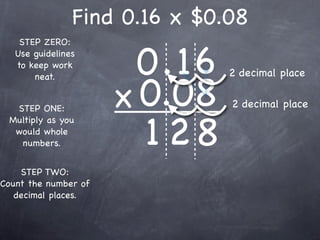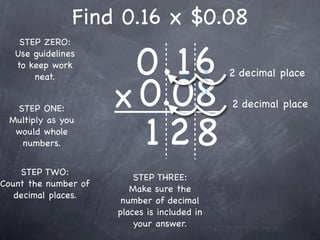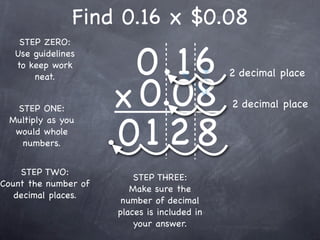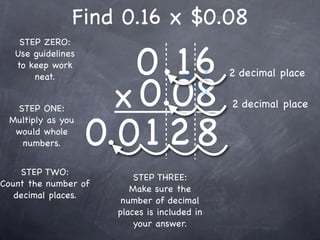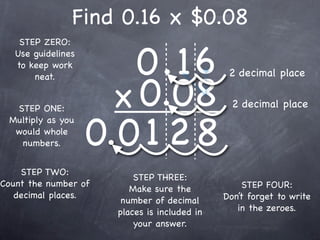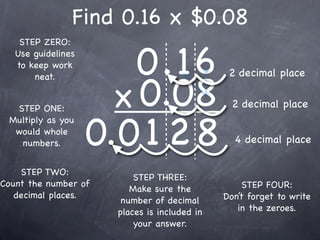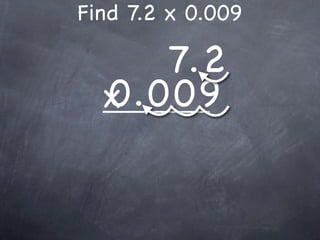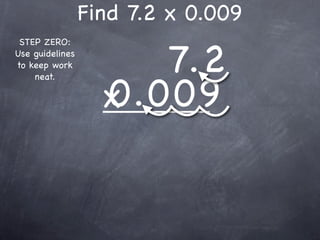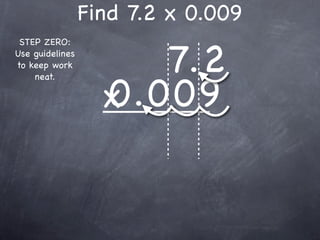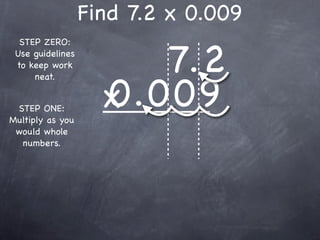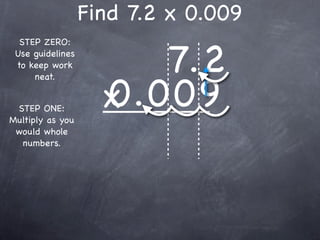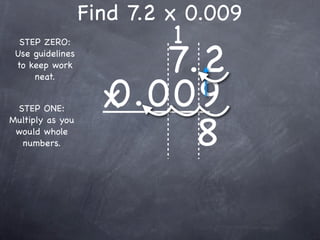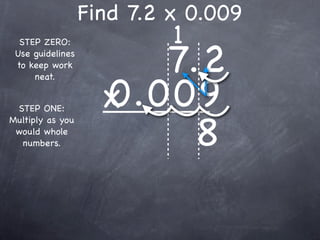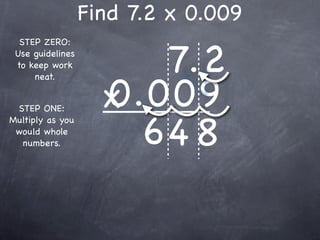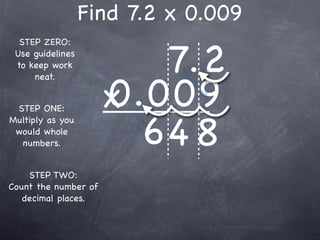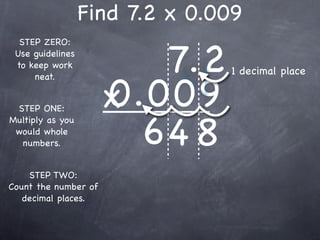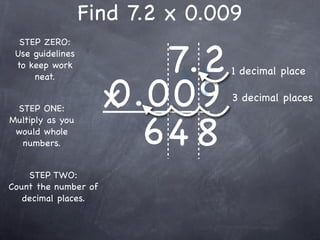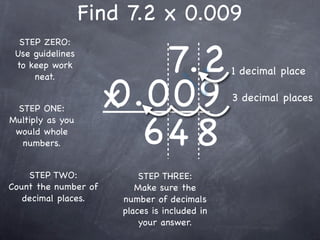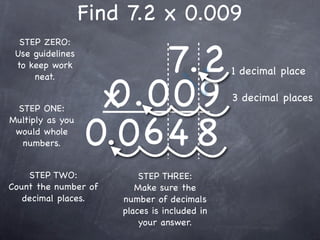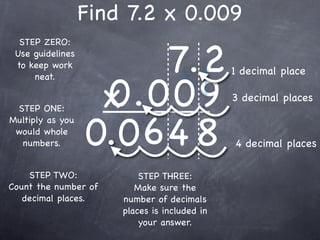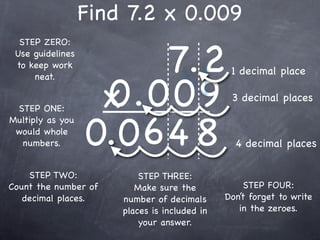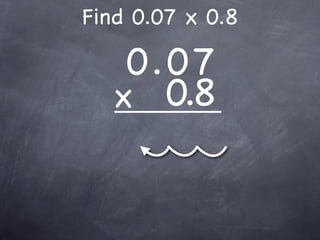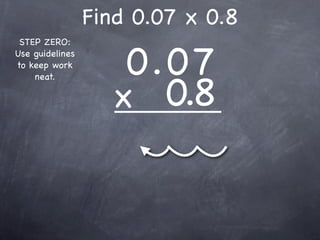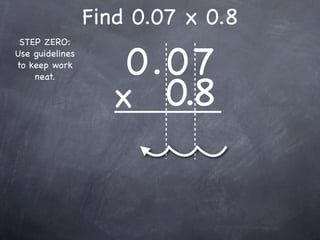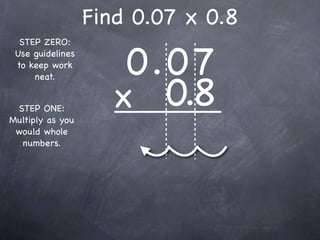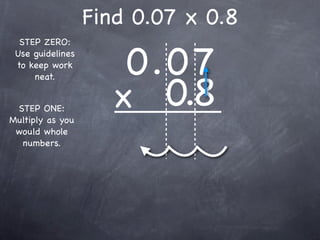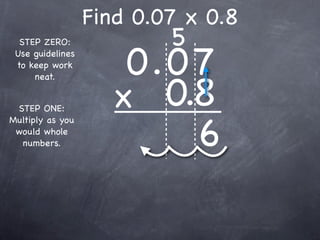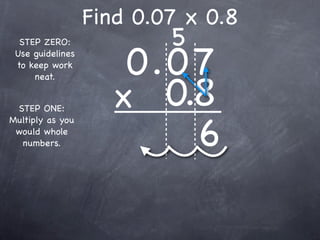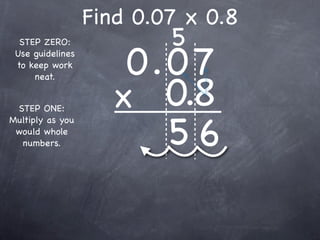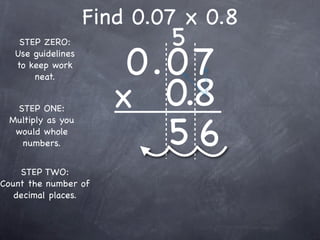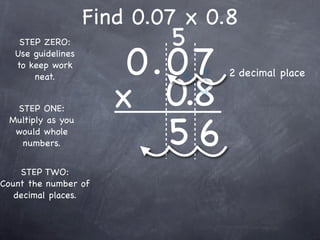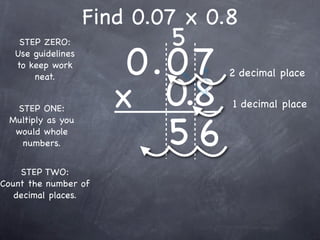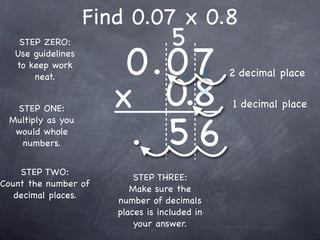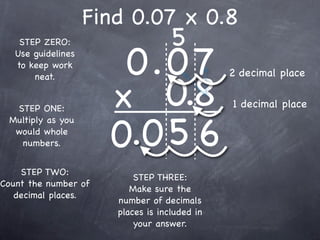6-6 Multiplying with Zeroes in the Product
- 1. 6-6 Multiplying with Zeroes in the Product Math Notes Number Sense 2.1
- 2. Find 0.16 x $0.08 0.16 x 0.08
- 3. Find 0.16 x $0.08 0.16 STEP ZERO: Use guidelines to keep work x 0.08 neat.
- 4. Find 0.16 x $0.08 0.16 STEP ZERO: Use guidelines to keep work x 0.08 neat.
- 5. Find 0.16 x $0.08 0.16 STEP ZERO: Use guidelines to keep work x 0.08 neat. STEP ONE: Multiply as you would whole numbers.
- 6. Find 0.16 x $0.08 0.16 STEP ZERO: Use guidelines to keep work x 0.08 neat. STEP ONE: Multiply as you would whole numbers.
- 7. Find 0.16 x $0.08 4 0.16 STEP ZERO: Use guidelines to keep work x 0.08 neat. STEP ONE: 8 Multiply as you would whole numbers.
- 8. Find 0.16 x $0.08 4 0.16 STEP ZERO: Use guidelines to keep work x 0.08 neat. STEP ONE: 8 Multiply as you would whole numbers.
- 9. Find 0.16 x $0.08 0.16 STEP ZERO: Use guidelines to keep work x 0.08 neat. STEP ONE: 128 Multiply as you would whole numbers.
- 10. Find 0.16 x $0.08 0.16 STEP ZERO: Use guidelines to keep work x 0.08 neat. STEP ONE: 128 Multiply as you would whole numbers. STEP TWO: Count the number of decimal places.
- 11. Find 0.16 x $0.08 0.16 STEP ZERO: Use guidelines to keep work x 0.08 neat. STEP ONE: 128 Multiply as you would whole numbers. STEP TWO: Count the number of decimal places.
- 12. Find 0.16 x $0.08 0.16 STEP ZERO: Use guidelines to keep work 2 decimal place x 0.08 neat. STEP ONE: 128 Multiply as you would whole numbers. STEP TWO: Count the number of decimal places.
- 13. Find 0.16 x $0.08 0.16 STEP ZERO: Use guidelines to keep work 2 decimal place x 0.08 neat. STEP ONE: 128 Multiply as you would whole numbers. STEP TWO: Count the number of decimal places.
- 14. Find 0.16 x $0.08 0.16 STEP ZERO: Use guidelines to keep work 2 decimal place x 0.08 neat. STEP ONE: 2 decimal place 128 Multiply as you would whole numbers. STEP TWO: Count the number of decimal places.
- 15. Find 0.16 x $0.08 0.16 STEP ZERO: Use guidelines to keep work 2 decimal place x 0.08 neat. STEP ONE: 2 decimal place 128 Multiply as you would whole numbers. STEP TWO: STEP THREE: Count the number of Make sure the decimal places. number of decimal places is included in your answer.
- 16. Find 0.16 x $0.08 0.16 STEP ZERO: Use guidelines to keep work 2 decimal place x 0.08 neat. STEP ONE: 2 decimal place . 128 Multiply as you would whole numbers. STEP TWO: STEP THREE: Count the number of Make sure the decimal places. number of decimal places is included in your answer.
- 17. Find 0.16 x $0.08 0.16 STEP ZERO: Use guidelines to keep work 2 decimal place x 0.08 neat. STEP ONE: 2 decimal place .0 1 2 8 Multiply as you would whole numbers. STEP TWO: STEP THREE: Count the number of Make sure the decimal places. number of decimal places is included in your answer.
- 18. Find 0.16 x $0.08 0.16 STEP ZERO: Use guidelines to keep work 2 decimal place x 0.08 neat. STEP ONE: 2 decimal place 0.0 1 2 8 Multiply as you would whole numbers. STEP TWO: STEP THREE: Count the number of Make sure the decimal places. number of decimal places is included in your answer.
- 19. Find 0.16 x $0.08 0.16 STEP ZERO: Use guidelines to keep work 2 decimal place x 0.08 neat. STEP ONE: 2 decimal place 0.0 1 2 8 Multiply as you would whole numbers. STEP TWO: STEP THREE: Count the number of STEP FOUR: Make sure the decimal places. DonŌĆÖt forget to write number of decimal places is included in in the zeroes. your answer.
- 20. Find 0.16 x $0.08 0.16 STEP ZERO: Use guidelines to keep work 2 decimal place x 0.08 neat. STEP ONE: 2 decimal place 0.0 1 2 8 Multiply as you would whole numbers. 4 decimal place STEP TWO: STEP THREE: Count the number of STEP FOUR: Make sure the decimal places. DonŌĆÖt forget to write number of decimal places is included in in the zeroes. your answer.
- 21. Find 7.2 x 0.009 7.2 0.009 x
- 22. Find 7.2 x 0.009 7.2 STEP ZERO: Use guidelines to keep work 0.009 neat. x
- 23. Find 7.2 x 0.009 7.2 STEP ZERO: Use guidelines to keep work 0.009 neat. x
- 24. Find 7.2 x 0.009 7.2 STEP ZERO: Use guidelines to keep work 0.009 neat. STEP ONE: Multiply as you x would whole numbers.
- 25. Find 7.2 x 0.009 7.2 STEP ZERO: Use guidelines to keep work 0.009 neat. STEP ONE: Multiply as you x would whole numbers.
- 26. Find 7.2 x 0.009 1 7.2 STEP ZERO: Use guidelines to keep work 0.009 neat. STEP ONE: x 8 Multiply as you would whole numbers.
- 27. Find 7.2 x 0.009 1 7.2 STEP ZERO: Use guidelines to keep work 0.009 neat. STEP ONE: x 8 Multiply as you would whole numbers.
- 28. Find 7.2 x 0.009 7.2 STEP ZERO: Use guidelines to keep work 0.009 neat. STEP ONE: x 64 8 Multiply as you would whole numbers.
- 29. Find 7.2 x 0.009 7.2 STEP ZERO: Use guidelines to keep work 0.009 neat. STEP ONE: x 64 8 Multiply as you would whole numbers. STEP TWO: Count the number of decimal places.
- 30. Find 7.2 x 0.009 7.2 STEP ZERO: Use guidelines to keep work 1 decimal place 0.009 neat. STEP ONE: x 64 8 Multiply as you would whole numbers. STEP TWO: Count the number of decimal places.
- 31. Find 7.2 x 0.009 7.2 STEP ZERO: Use guidelines to keep work 1 decimal place 0.009 neat. STEP ONE: x 3 decimal places 64 8 Multiply as you would whole numbers. STEP TWO: Count the number of decimal places.
- 32. Find 7.2 x 0.009 7.2 STEP ZERO: Use guidelines to keep work 1 decimal place 0.009 neat. STEP ONE: x 3 decimal places 64 8 Multiply as you would whole numbers. STEP TWO: STEP THREE: Count the number of Make sure the decimal places. number of decimals places is included in your answer.
- 33. Find 7.2 x 0.009 7.2 STEP ZERO: Use guidelines to keep work 1 decimal place 0.009 neat. STEP ONE: x 3 decimal places . 64 8 Multiply as you would whole numbers. STEP TWO: STEP THREE: Count the number of Make sure the decimal places. number of decimals places is included in your answer.
- 34. Find 7.2 x 0.009 7.2 STEP ZERO: Use guidelines to keep work 1 decimal place 0.009 neat. STEP ONE: x 3 decimal places .0 6 4 8 Multiply as you would whole numbers. STEP TWO: STEP THREE: Count the number of Make sure the decimal places. number of decimals places is included in your answer.
- 35. Find 7.2 x 0.009 7.2 STEP ZERO: Use guidelines to keep work 1 decimal place 0.009 neat. STEP ONE: x 3 decimal places 0.0 6 4 8 Multiply as you would whole numbers. STEP TWO: STEP THREE: Count the number of Make sure the decimal places. number of decimals places is included in your answer.
- 36. Find 7.2 x 0.009 7.2 STEP ZERO: Use guidelines to keep work 1 decimal place 0.009 neat. STEP ONE: x 3 decimal places 0.0 6 4 8 Multiply as you would whole numbers. 4 decimal places STEP TWO: STEP THREE: Count the number of Make sure the decimal places. number of decimals places is included in your answer.
- 37. Find 7.2 x 0.009 7.2 STEP ZERO: Use guidelines to keep work 1 decimal place 0.009 neat. STEP ONE: x 3 decimal places 0.0 6 4 8 Multiply as you would whole numbers. 4 decimal places STEP TWO: STEP THREE: Count the number of Make sure the STEP FOUR: decimal places. number of decimals DonŌĆÖt forget to write places is included in in the zeroes. your answer.
- 38. Find 0.07 x 0.8 0.0 7 x 0.8
- 39. Find 0.07 x 0.8 0.0 7 STEP ZERO: Use guidelines to keep work x 0.8 neat.
- 40. Find 0.07 x 0.8 0.0 7 STEP ZERO: Use guidelines to keep work x 0.8 neat.
- 41. Find 0.07 x 0.8 0.0 7 STEP ZERO: Use guidelines to keep work x 0.8 neat. STEP ONE: Multiply as you would whole numbers.
- 42. Find 0.07 x 0.8 0.0 7 STEP ZERO: Use guidelines to keep work x 0.8 neat. STEP ONE: Multiply as you would whole numbers.
- 43. Find 0.07 x 0.8 5 0.0 7 STEP ZERO: Use guidelines to keep work x 0.8 neat. STEP ONE: 6 Multiply as you would whole numbers.
- 44. Find 0.07 x 0.8 5 0.0 7 STEP ZERO: Use guidelines to keep work x 0.8 neat. STEP ONE: 6 Multiply as you would whole numbers.
- 45. Find 0.07 x 0.8 5 0.0 7 STEP ZERO: Use guidelines to keep work x 0.8 neat. STEP ONE: 56 Multiply as you would whole numbers.
- 46. Find 0.07 x 0.8 5 0.0 7 STEP ZERO: Use guidelines to keep work x 0.8 neat. STEP ONE: 56 Multiply as you would whole numbers. STEP TWO: Count the number of decimal places.
- 47. Find 0.07 x 0.8 5 0.0 7 STEP ZERO: Use guidelines to keep work 2 decimal place x 0.8 neat. STEP ONE: 56 Multiply as you would whole numbers. STEP TWO: Count the number of decimal places.
- 48. Find 0.07 x 0.8 5 0.0 7 STEP ZERO: Use guidelines to keep work 2 decimal place x 0.8 neat. STEP ONE: 1 decimal place 56 Multiply as you would whole numbers. STEP TWO: Count the number of decimal places.
- 49. Find 0.07 x 0.8 5 0.0 7 STEP ZERO: Use guidelines to keep work 2 decimal place x 0.8 neat. STEP ONE: 1 decimal place . 56 Multiply as you would whole numbers. STEP TWO: STEP THREE: Count the number of Make sure the decimal places. number of decimals places is included in your answer.
- 50. Find 0.07 x 0.8 5 0.0 7 STEP ZERO: Use guidelines to keep work 2 decimal place x 0.8 neat. STEP ONE: 1 decimal place .0 5 6 Multiply as you would whole numbers. STEP TWO: STEP THREE: Count the number of Make sure the decimal places. number of decimals places is included in your answer.
- 51. Find 0.07 x 0.8 5 0.0 7 STEP ZERO: Use guidelines to keep work 2 decimal place x 0.8 neat. STEP ONE: 1 decimal place 0.0 5 6 Multiply as you would whole numbers. STEP TWO: STEP THREE: Count the number of Make sure the decimal places. number of decimals places is included in your answer.
- 52. Find 0.07 x 0.8 5 0.0 7 STEP ZERO: Use guidelines to keep work 2 decimal place x 0.8 neat. STEP ONE: 1 decimal place 0.0 5 6 Multiply as you would whole numbers. STEP TWO: STEP THREE: Count the number of STEP FOUR: Make sure the decimal places. DonŌĆÖt forget to write number of decimals places is included in in the zeroes. your answer.
- 53. Find 0.07 x 0.8 5 0.0 7 STEP ZERO: Use guidelines to keep work 2 decimal place x 0.8 neat. STEP ONE: 1 decimal place 0.0 5 6 Multiply as you would whole numbers. 3 decimal place STEP TWO: STEP THREE: Count the number of STEP FOUR: Make sure the decimal places. DonŌĆÖt forget to write number of decimals places is included in in the zeroes. your answer.






